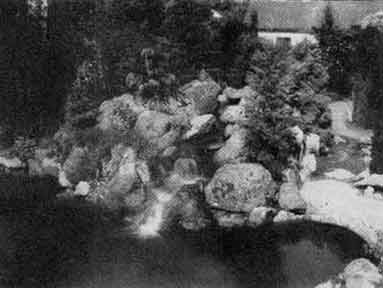Garden Pools: Whether Formal or Naturalistic, They Add Unequalled Charm
By ROMAINE B. WARE
Nature Magazine, March 1932
Page 1 | Page 2 | Page 3 | Page 4
A little girl I knew used to say she always imagined that fairies lived among the waterlilies in her garden pool. And surely such a place would be an ideal home for the "wee sma' folk" of legend and tradition, did they exist. Even such matter of fact folk as we humans find ourselves irresistibly drawn to the pools that are the bright jewels of our gardens.
A bit of sparkling water adds a degree of charm obtainable in no other way. From tiny puddles containing only a half barrel or so of water up to elaborate marble or tile lined bowls with fountains and statuary, the medium is the same. Water, with its ever interesting surface reflections, its play of light and shadow, quickly becomes the center of attraction.

CASCADES FROM A ROCKY HILLSIDE FEED THE POOL
Gardeners in all sections of the country are fast finding the values in pools, waterfalls and rocks arranged and planted in a naturalistic manner. And popular opinion to the contrary notwithstanding, a pool is within the reach of practically any purse. The size has little to do with the attractiveness. I have seen tiny basins with less than two square yards of water surface which were far more charming than other pools many times as large. Charm is largely a matter of the skill with which the garden maker handles his subject.
The method of introducing a water feature into one's garden will vary greatly, as there are so many possibilities of arrangement and planting. Pools both formal and informal, streams, fountains, cascades or combinations of different effects afford a wide variety of treatments. Simple pools are the most common. The type you choose is largely a matter of taste. Formal types are more in keeping with formal architecture and gardening. Informal or naturalistic ones are more suitable to rock gardens and the informal hardy borders so popular today. Fountains are out of place in any but extremely formal settings. Cascades and waterfalls belong to informal treatments. They are excellent when well done but demand skill and understanding.
If your garden aspirations include a pool and waterlilies there are many factors to be considered. The simplest form possible is a rectangular or square pool with cement coping. It is not the most attractive from some viewpoints but when placed in the open lawn or upon a terrace adjacent to the house, is usually to be preferred. To fit the naturalistic pool into such locations is frequently difficult. Formal pools may be made quite elaborate by the use of marble, tile, cut stone or brick coping. If close to the house, they must be architecturally correct. They also demand clear sparkling water while that in many natural ponds is somewhat discolored from vegetation.
A formal pool may be of almost any size and depth, but if it is co contain waterlilies the depth should be limited to a foot or two. Lilies need about a foot of water above their soil surface. The shallow types have two additional advantages. The water within them warms up more quickly, which is favorable to both lilies and goldfish, and the darting fish are more readily seen. An excellent method of construction calls for a depth of one foot with round or square wells a foot deeper to hold boxes containing lilies. A formal pool may be made with its water surface at a level either above or below the surrounding soil, but the informal varieties must always be made in the lowest spot, as in Nature water seeks the lowest level. We must follow Nature.
 Printer-friendly version
Printer-friendly version
